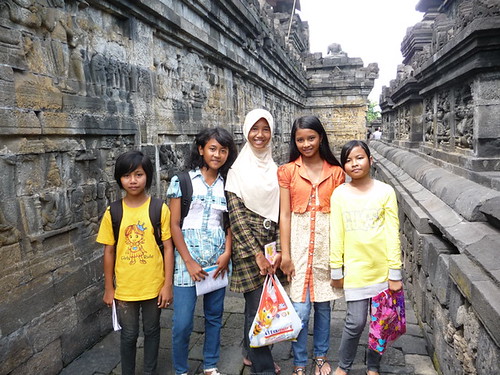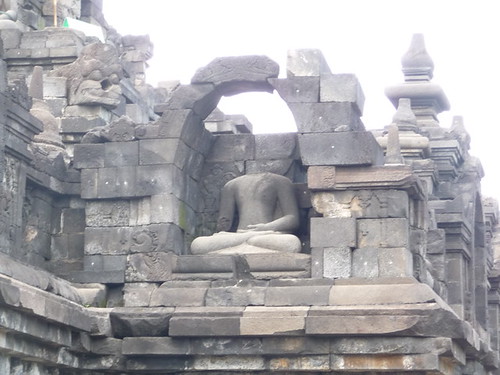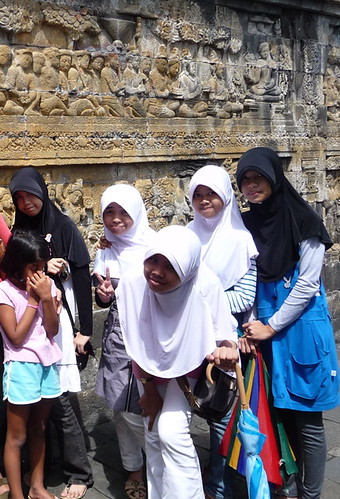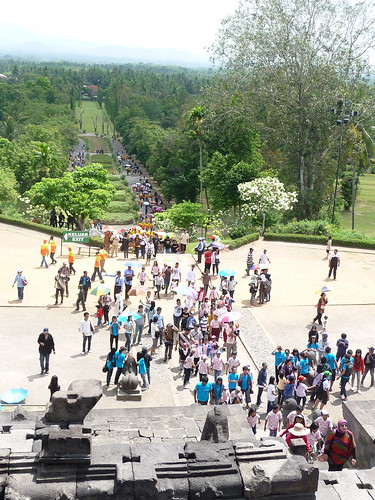
I have always found people more fascinating than buildings. There are those (like my wife) who can spend days and weeks, sometimes even their entire lives, tracking down the hidden stories and clues that buildings offer us. Me? I prefer to watch the man making his monkey do tricks at the entrance of the Red Fort.
So it is a small surprise that I was only mildly enthused about visiting Borobudur during our Jogyakarta/Bali trip. Scoff if you must, and call me a philistine. After all, Borobudur is one of the hidden treasures of the world. Remind me that I said the same thing when we were first driving towards Angkor Wat during our December 2006 trip to Cambodia. The reality is that I was not excited about going to see this magnificent Mahayana Buddhist monument.
Even with this mild discontent, it is difficult to conceal that first moment when the vantage point opens up. The close to 1/2 mile long walk leading up to the majestic monument allows you to take in the enormity of the project, let it sink in slowly. And sink in it did. I was pleased that this was a perambulatory. It meant we would have to climb. At least there would be movement.
We traversed the first set of stairs and sat in the first level enclosure. As we did, three girls with a notebook approached us and asked us if they could speak to us. Being well trained South Asians with a suspicion for all strangers in big places, we tersely said no and walked away. As I sat and watched, I noticed that small clusters of kids were approaching tourists and foreigners as they came up that first set of stairs. It seemed like they were having a conversation.
I was curious.
When a group of six school girls approached us on the second level, I didn't shoo them away.
"Hello Mister, are you busy?"
"No".
"We are from xxxx school and we would like to practice English with you."
(I slowly started to understand but was still cautious)
"Sure."
The girl beamed and her friends quickly gathered. They pulled out a notebook and began to read out their practice questions.
"What is your name?"
"What is your favorite color?"
"How old are you?"
I tried to get my daughter to answer. She preferred to watch curiously.
I was waiting for a sell at some point during the conversation.
It never came.
After an enjoyable few minutes, the kids said thank you and left.
I was delighted.

We walked around taking in the myriad seated Buddha statues, many of which were decapitated

When the next group of kids showed up I was much more relaxed. I asked them questions back. Turns out the teachers in the local schools had discovered a novel way to get their kids to practice spoken English. Go mix with the natives. So they did these field trips to Borobudur and Prambanan, walked up to total strangers, and asked them questions in English.
Some kids had a ringleader. The rest would observe and nod. I tried a couple of times to make them all talk. Most of the kids had cameras, and wanted to take a picture of us. We said no the first couple of times but then realized they were going to show it to their teacher, and started saying yes. Soon we started taking pictures of the kids.
The most striking thing was how alive they were. I suppose all kids are. They are a constant rejuvenation wherever I go. No doubt their lives were not easy. But there, on that day, they were kids again, running around together, having fun doing a school assignment.

Clothed in burkas, totally modest and polite, they exhibited a childish joy when the shutter click moment came, flashing their peace signs.
As I took my Borobudur pictures, I found they sprang to life when I included the visitors. Even though it is believed that the temple was abandoned when the Javanese converted to Islam and the Hindu and Buddhist Kingdoms died out, it was clear that these modern Muslims still held a great curiousity and interest in the monument.

I did two more English lessons that day. The last one was with a group of college kids. They ran over to us as I was waiting for my wife and daughter to return from a bathroom trip. The kids were smart, friendly and enthusiastic. It was clear they were Gen Y'ers. Everybody flashed their cell phones, and all grinned when I asked if they were on FaceBook.
"Of course!"
They told me that a fluent English speaker earned 25% more in a white collar job than a non-fluent speaker. The problem was that they had little opportunity to practice. This idea of practicing with tourists was recent. Had I more time, I would have loved to go and spend a few days at their college or school and just sit and talk to these kids. Perhaps they were practicing their English with me, but I was learning so much from them.
By the time I left the premises, I was sated. I had taken in one of the historical wonders of the world, and had spent time with the ones that would carry the future of this planet.
All in all, a good day.
"Perhaps they were practicing their English with me, but I was learning so much from them."
ReplyDeleteThat says it all :)
Interesting as usual Brenny. :)
@shail. Yes indeed. Thanks for visiting. I'll pop by your nest once in a while as well. Maybe it'll be like old times.
ReplyDeletewhat a lovely post!
ReplyDeleteeven i am more into people.so when people ask the hackneyed "sea or mountain?" question, i say "city".
i asked this little boy to guide me through the Taj and even though he knew little about the monument,he made it a point to tell me of all the films shot there and sang me two lines of each song shot there :)
@rhea. I do love the word 'hackneyed' I will try and use it in a sentence today. So that's the other thing about travelling. I love using guides because they make the place come alive with stories that give the space meaning. I love the urban myths even more than factually accurate information.
ReplyDelete